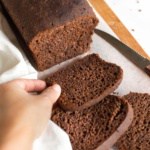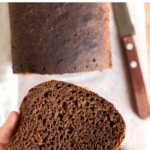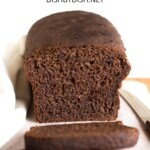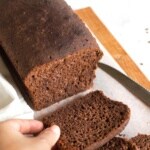Description
This gluten-free pumpernickel bread is perfect for toasting and spreading with cream cheese or butter, or for making sandwiches, or dipping in soups. Made with teff flour for fiber and texture, this beautifully dark pumpernickel bread recipe is going to be a favorite, so make sure to keep it handy! Bake a loaf or two and freeze to enjoy homemade bread anytime. Totally dairy-free too, but no one would care!
Ingredients
- 1 1/2 cups gluten-free all-purpose flour
- 3/4 teaspoon xanthan gum (omit if your flour blend already includes it)
- 3/4 cups teff flour
- 2 tablespoons psyllium husk powder
- 1/4 cup unsweetened cocoa powder
- 1 teaspoon baking powder
- 2 1/4 teaspoons instant yeast
- 1 tablespoon sugar
- 1 teaspoon salt
- 1/4 cup molasses
- 1/3 cup sunflower oil
- 1 teaspoon vinegar
- 1 1/3 cups warm water (between 105F to 115F)
- 2 large eggs, beaten
Instructions
- Preheat and Grease: Grease an 8″ x 4″ metal loaf pan and then preheat the oven to 350F. Arrange the oven rack to the middle position.
- Combine Dry Ingredients: In a large mixing bowl, combine the gluten-free all-purpose flour, xanthan gum (if using), teff flour, psyllium husk powder, unsweetened cocoa powder, baking powder, instant yeast, sugar and salt. Whisk well to combine.
- Add Wet Ingredients: Add the molasses, sunflower oil, vinegar, warm water, and beaten eggs to the large bowl with the dry ingredients. Mix well until you get a wet, sticky dough that resembles brown cake batter.
- Transfer to Loaf Pan: Transfer the pumpernickel bread dough to the previously-greased loaf pan and smooth out the top with a wet spatula.
- Let Rise: Let the dough rise in a warm, draft-free place for at least 30 minutes until it has doubled in size.
- Bake Until Ready: Bake the dough for 50 to 60 minutes until loaf is dark brown on top and sounds hollow when tapped.
- Cool Fully: Allow the gluten-free pumpernickel loaf to cool for at least 10 minutes in the loaf pan before removing it and letting it cool completely at room temperature on a wire rack.
- Slice and Enjoy: Once the loaf has fully cooled, slice and enjoy!
Notes
Gluten-Free All-Purpose Flour: I recommend using a good-quality gluten-free all-purpose flour blend that includes lighter flours and starches (such as rice flour, tapioca starch, corn starch or potato starch) to ensure a lighter final texture. I do NOT recommend using a gluten-free flour blend that includes heavier flours (such as garbanzo bean flour) as that will result in a very dense final texture.
Xanthan Gum: Xanthan gum is the replacement for gluten in gluten-free flours, so I recommend adding it if your gluten-free flour blend does not already include it.
Teff Flour: I used teff flour to give the pumpernickel dough its characteristically darker color and high-fiber texture. However, you may also use a mix of wholegrain gluten-free flours such as buckwheat flour, millet flour, sorghum flour and brown rice flour if you prefer.
Psyllium Husk Powder: Psyllium husk powder helps to better bind the ingredients together and gives the dough the elasticity required when it is rising and to maintain its dome shape once risen.
Cocoa Powder: I’ve added unsweetened cocoa powder give the pumpernickel loaf its traditionally darker color. You may also use equal amounts of unsweetened cacao powder if you prefer.
Baking Powder: This bread recipe using both baking powder and yeast to give the dough extra rising power. If you are Celiac or gluten-intolerant, make sure to use certified gluten-free baking powder.
Instant Yeast: I like using instant yeast because there is no pre-activation time required, and you can mix the yeast directly with the dry ingredients. If you only have active dry yeast, simply activate it beforehand with the warm water and sugar before adding it to the other ingredients.
Sugar: Sugar is needed as “food” for the yeast to feed on in order to produce the gases required for making the dough rise. I used while sugar, but you can also use light brown sugar or dark brown sugar if you prefer.
Molasses: In addition to the cocoa powder, the molasses also adds to the rich brown color of the loaf once fully baked. You may also use honey, maple syrup, or agave nectar if you prefer.
Sunflower Oil: I like using sunflower oil because I always have a bottle of it on hand. You may use other vegetable oils such as olive oil, melted coconut oil, or avocado oil if you prefer. Alternatively, if you are not lactose-intolerant, feel free to use melted butter or ghee if you like.
Vinegar: Vinegar creates an acidic environment that reacts with the alkaline nature of baking powder to create the gases which cause the air bubbles in bread dough to form. You may also use equal amounts of apple cider vinegar if you prefer.
Warm Water: Make sure that the water used is between 105F to 115F, because the warmth is needed to activate the yeast, but if the water is too hot, it will kill the yeast instead. Alternatively, if you prefer, you can also use warm dairy-free milk (such as almond milk, cashew milk, rice milk, or oat milk).
Eggs: Eggs help to bind the ingredients together, as well to give the bread dough rise. I have not tried making this recipe without eggs, but if you are allergic to eggs, you can try substituting the eggs with acquafaba or an egg-replacer. (If you do make this recipe without eggs, please let me know how it goes in the comments below. I’d love to know!)
Storing/Freezing: To store, place the cooled pumpernickel loaf in an airtight container or wrap it in various layers of plastic wrap, then store in the refrigerator for up to 5 days. To freeze, wrap the cooled gluten-free pumpernickel in various layers of plastic wrap and freeze for up to 2 months. Let loaf thaw completely overnight in the refrigerator before slicing.
- Prep Time: 10 mins
- Rising Time: 30 mins
- Cook Time: 60 mins
- Category: Bread
- Method: Baking
- Cuisine: Western



